On Saturday May 7, 1960, ABW Channel 2 in Perth opened.
Broadcasting began with radio and when moving pictures were added it became television. Both started as wireless but now are delivered by an ever increasing variety of means. Analogue broadcasts have evolved into high definition digital signals being delivered terrestrially or by satellite, and in different forms through the internet and mobile phones.
The principle national public broadcaster is a comprehensive service provider known as the Australian Broadcasting Corporation (ABC), which operates four national radio networks – ABC Radio National, ABC Classic FM, triple j and ABC NewsRadio – as well as 60 Local Radio stations around Australia, and three internet music-based services, dig, dig jazz and dig country. Dig and dig jazz are also available on free-to-air digital and subscription television platforms. The ABC also operates an international satellite television service aimed at the Asia-Pacific region and a commercial division composed of ABC Retail, ABC Consumer Publishing and Content Sales, as well as ABC Resource Hire. The Homestead & Community Broadcasting Satellite Service (HACBSS) which started in late 1985. Rural viewers with a 1.5m dish could get two TV Channels, ABC FM stereo, ABC Radio National, and a State base ABC Regional Radio. The digital Remote Area Broadcasting Service (RABS) replaced the analogue HACBSS in late 1998. Now rural Western Australians receive ABC-TV, Regional Radio, Radio National and Classic FM via the RABS. Triple J and News Radio are also broadcast in various rural areas.
Broadcasting in WA dates back to 1924 when Western Farmers Limited (Wesfarmers) began operating radio station 6WF from the top floor of the company’s Wellington Street building. Wesfarmers also manufactured and sold the ‘Mulgaphone’ radio receivers.
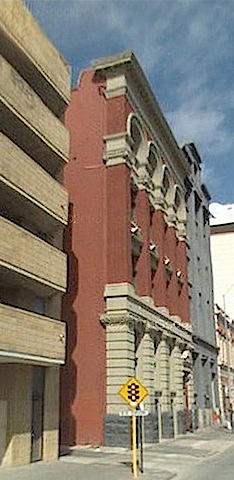
Following a Royal Commission in 1927, the Commonwealth Government took over all the principal radio stations in Australia. It also nationalised the Australian Broadcasting Company which had been created by entertainment interests to supply programs to various radio stations.
In 1929, 6WF was taken over by the Australian Broadcasting Company and moved from the Wesfarmers building to the English, Scottish and Australian Bank (E.S. & A.) building at the corner of Hay and Milligan Street, Perth. The ABC set up its operation on the first floor, which was an empty space that was partitioned for the use of offices and contained toilets to the north of the building. In 1936 the ABC offices moved to 936 Hay Street, whilst the studio remained on the first floor above 938 and 940 Hay Street. Former Sydney radio 2BL announcer and sports commentator Basil Kirke moved to Western Australia in 1929 as manager of 6WF. 2BL started off as a commercial but later became one of the ABC’s inaugural radio stations. Kirke was full of energy and drive and attracted listeners with daring antics such as broadcasting from the seabed off Cottesloe and from inside Yallingup caves.
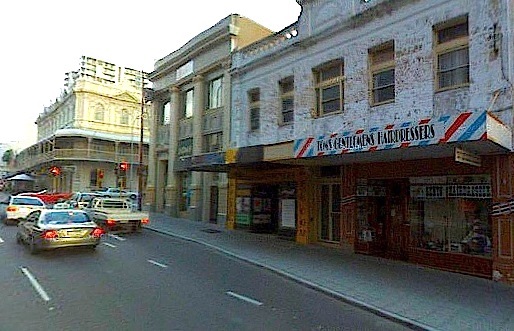
On July 1, 1932, the Australian Broadcasting Commission Act was passed, following which The Australian Broadcasting Commission took over the premises and the 6WF transmitter was relocated to Wanneroo (now called Hamersley) by the end of that year. Basil Kirke moved to Victoria in 1936 as manager, before filling that same role in New South Wales.
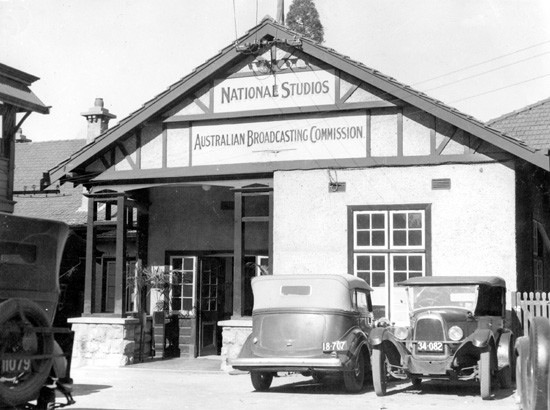
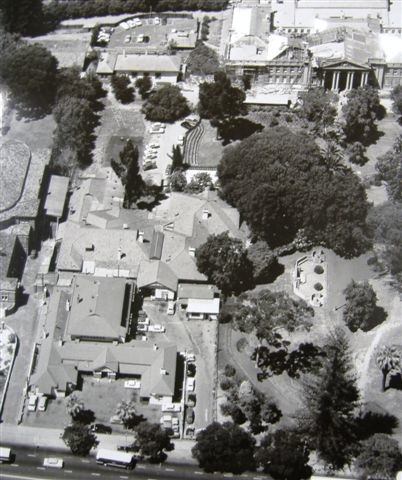
In 1937 the Commission moved its studios and staff to the Soldiers’ Institute in St Georges Terrace, which they took over from the Returned Sailors and Soldiers Imperial League of Australia (now known as the RSL), after they moved into ANZAC House in 1934. This temporary building was constructed in 1916 as a rest and recreation centre for sick and wounded sailors and soldiers returning from the First World War. It was located on the edge of the Supreme Court Gardens, next to the Government House Ballroom. The building was renamed ‘Broadcast House’ and used for 21 years before a multi-studio complex was built in 1958, on the former site of Rose Hill House, at 191 Adelaide Terrace. ABC radio moved to the new facilities in 1959, whilst work continued on the television building on the lower part of the site, facing Terrace Road. Much of the credit for the new building goes to Basil Kirke, who returned to Western Australia as manager in 1953 and lobbied tirelessly for new offices and studios. He fell seriously ill in 1957 and died in 1958, before the move to the new premises took place. In 1961 the large orchestral studio 620 was named in his honour.
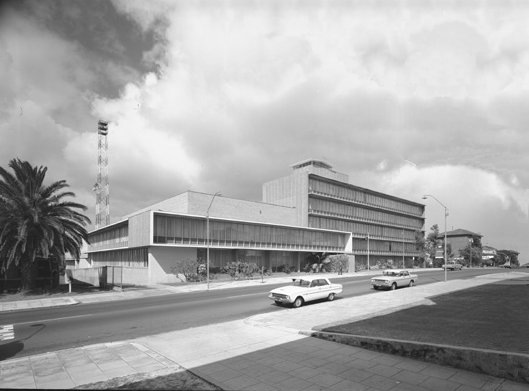
In March 1960, the ABC State manager Eric Scholl headed an auditioning board to select three TV announcers from 50 applicants, who were short listed. Meanwhile the Bickley transmitter was nearing completion and the studio taking shape under the watchful eye of experts from the British suppliers. Vital equipment included EMI electronic studio cameras and PYE telecine 16mm film transmission facilities. With only two months to opening night the ABW Studio 61 was a frenzy of activity with cable laying, lighting battens and curtains being installed and camera tests underway. With one month to go senior technician Warren Jacobs wheeled the first black and white EMI studio camera into the studio and fired it up for technical producer John Cahill’s critical eye.
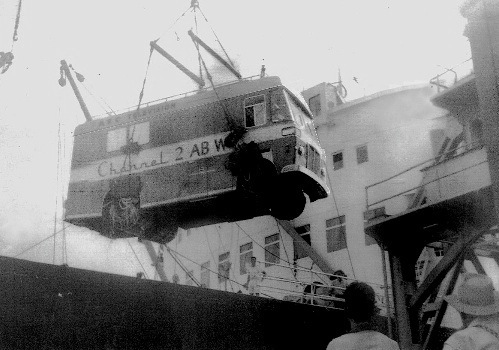
On Tuesday April 19, 1960, ABW Channel 2 trade transmissions began from 1pm to 10pm every day of the week, broadcasting the test pattern and music at full strength.
On Saturday April 23, 1960, ABW’s EMI outside broadcast van was deployed for the first time with three cameras and a 22-man team. It was sent to the Bayswater Oval, to cover a soccer match, as a full-dress rehearsal for future sporting events. Mike Altria was one of the first outside broadcast technicians who later became Head of OB Operations. The OB was monitored back at the studio by supervising engineer David Hirst and supervisor of production facilities David Moore. Staff then decided to substitute the live OB for the test pattern and music, to the surprise of householders who were watching the test transmission. Viewers quickly responded by ringing the station to report excellent reception. Not a bad effort considering the OB van arrived six weeks earlier.
ABC producers of that era included Jock Millett and Bryan Todd. Jock was a former BBC man who came to Perth from ABV2 in Melbourne where he concentrated on documentaries, talks and sporting shows. ABW planned to place the accent on live shows, sport, variety and interviews.
On Saturday May 7, 1960, Opening Night, there was 15 minutes of speeches from dignitaries prior to the official opening. The WA Director of Posts and Telegraphs H.B. Halvorsen introduced the ABC chairman Sir Richard Boyer, who then handed over to the Postmaster-General C. W. Davidson to officially open the station at 7pm.
The first ABC TV news bulletin was then broadcast, read by James Fisher. This was then followed by the station’s only western, Tales Of Wells Fargo, then the madcap US army based Phil Silvers Show. At 8.30pm the BBC series Portraits of Power, then the British courtroom drama Boyd, QC. Next at 9.30pm was a live twenty minutes studio show followed by a sporting session. The first night concluded with a prize winning ABC documentary titled ‘Up With Guba’ which was the story of New Guineas’ development. The station closed at 10.35pm.
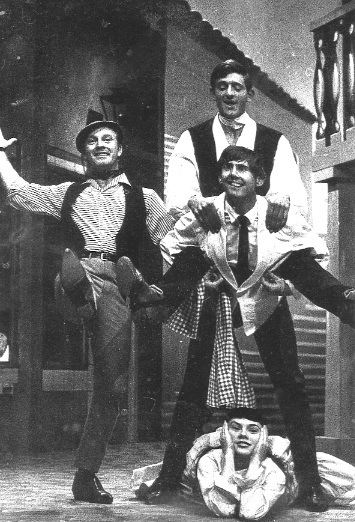
ABW placed the accent on live shows, sport, variety and interviews.
- Roundabout was a half-hour magazine program at 9.30pm on Thursdays which included interviews, live variety and music.
- Woman’s World was a half hour session broadcast at 4pm on Wednesdays.
- Sports Cavalcade on Wednesday evenings, Sports Preview on Friday evenings and Sports Review on Saturdays. Outside broadcasts of sport each Saturday.
- Perth Pictorial a 15 minute interview show on Tuesdays.
- Focus a five minute talks program with a different guest speaker each week on Wednesdays.
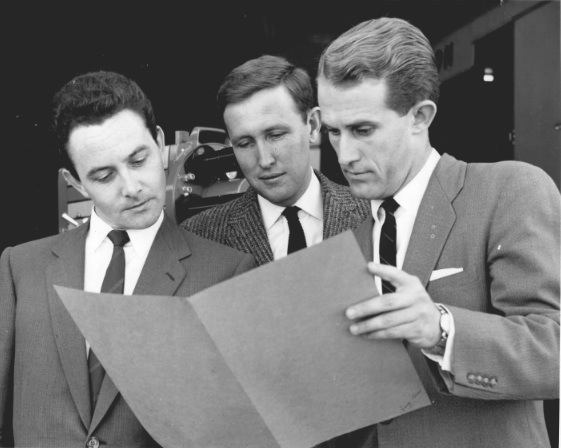
Early on-air staff included…
- First ABC TV Newsreader in Perth was Jim Fisher
- First on-air presentation announcer was Ian Beatty
- Sandra Harris – On-air presentation announcer
- Diana Ward – On-air presentation announcer
- Clive Hale – Newsreader and on-air presentation announcer
- Jenny Edwards (married to Hugh Edwards of ship wrecks fame) – On-air presentation announcer
- Jennifer West – On-air presentation announcer
- John Treffry – Weather presenter and To Market to Market
- Jim Fitzmaurice – Sports
- Peter Harrison – Sportsview (Saturday Afternoons) Presenter
- Geoff Walker was the first television newsreader in WA on TVW but later rejoined the ABC as a Newsreader, Weather and on-air presentation announcer
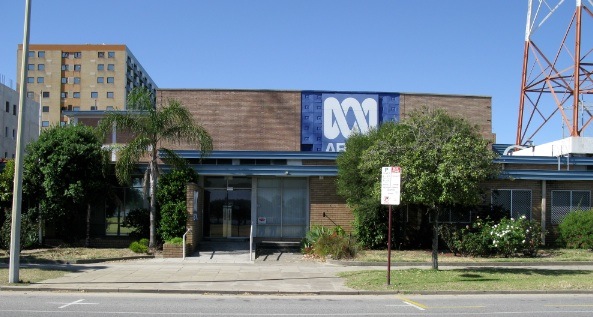
ABW Channel 2 occupied the site at 191 Adelaide Terrace for 45 years and ABC Radio for one year more. The building was designed to accommodate more than 700 people, including the Western Australian Symphony Orchestra (WASO). The level of local production justified the employment of a host of professional and trades people, including carpenters for set design and metal workers for electronic chassis and console making, graphic artists, circuit draftsmen, OB truck drivers, scaffolding riggers and air-conditioning mechanics. There were creative people such as musicians, dancers, writers, announcers and actors, some on the permanent staff whilst others were casual or contract, such as transient performers. There were producers, programmers and many support staff. There were reporters and journalists who working in the News, Current Affairs and Talks departments. There was a need for highly educated people with enquiring minds to break new ground in the fields of investigative reporting and current affairs. Like the BBC, the ABC was a pioneer in nature and history documentary making too. The news bulletins were straight reporting of stories that were accurate and impartial, whilst This Day Tonight, Four Corners and other shows of that ilk were probing, often controversial and ground breaking for the day. There were academics and former school teachers in the Education Department. People with agricultural degrees and knowledge of meteorology in the Rural department. There were even people conversant with theology in the Religious department. Administrators, accountants, clerical staff, human resource people, and a property and despatch departments serviced the needs of the organisation. There were qualified and trained engineers, technicians and operators. Receptionists, telephonists, typists and tea ladies. Cadet journalists, announcers, technicians and operators were trained and the ABC had its own training department, which conducted courses of study and examinations for technical staff. The down side was that the ABC became a popular recruitment area for technicians and engineers, thus robbing it of skilled people who gained qualifications at the corporation’s expense.
Local television and radio presentation was very labour intensive. TV needed specially trained staff to work the telecine, videotape, continuity booths and master control areas, with others busy filming stories, editing and sound mixing. In both mediums, people needed a good sense of time and an ability to work under pressure, so that any pending on-air disasters could be averted. They also needed to stay cool should there be a disruption and calmly restore services with out the event being overly apparent.
It was a different era than today. The trend was against employing married women and the organisational structure was more formal and rigid. Each person had clearly defined roles and there was much less multitasking. The spoken word was delivered with a voice approximating the British accent, for in those days the BBC was the model the ABC emulated. Many commercial announcers auditioned for the ABC, but few came up to the ABC’s high standards. A television presenter also presented radio programs. For if any role involved multitasking, then it was the announcers. Not only did they need an immaculate voice with wonderful breath control, but their pronunciation needed to be perfect, their knowledge of current events had to be considerable, and they needed skills in presenting everything from popular music to the classics. To appear as an authority on any subject was important, for if ever there was a technical glitch, these skills proved invaluable covering the occasion and drawing the listeners or viewers attention away from the problem. Particularly when commentating solemn events such as a church service, an ANZAC parade or a Royal Visit. Early announcers often produced their own radio programs, but in later years there was a trend towards employing producers and journalists as presenters when programs moved away from pure entertainment into telephone talkback, interviews and story chasing. The traditional announcers migrated to news reading, whilst less trained voices took over the airwaves, often with an Australian accent.
There were also some very quaint aspects to the ABC in the earlier decades. Pioneering announcers wore formal wear, even though they were not seen by anyone other than visiting guests, other staff and management. There were two entrances to the ABC when the studios moved to Adelaide Terrace. Concierges had to meet visitors and staff at both the Adelaide Terrace and Terrace Road entrances and senior management were chauffeur-driven.
It was a vast site with a large multi-story administration block facing Adelaide Terrace, another vast building housed the radio network and production studios. The radio studio numbering was to change a number of times over the years. Studio 620 was the Basil Kirke WASO studio, 621 was a chamber music studio often used for rock band recording or social functions, the studio originally designated 612 was a music studio for smaller productions, 611 was first a talks studio then later a network studio and 610 was dedicated to radio dramas complete with all sorts of sound effects paraphernalia. On the other side of the corridor was a massive record library, and next came the network studios with 601 for the northern regionals, 602 was the original 6WF studio before given to 6WN and later renamed to once again house 6WF when it became known as 720. 603 was the original 6WN studio, then became the 6WF studio with sporting panel facilities to finally be renamed and become the Radio Regional studio. 604 served a number of purposes, with the earlier years being a Southern Regionals program source, after the remote regional studios staff went home for the night. The television site was down the hill on the river end of the block. It was a long trek from TV land to the canteen, which was located near the radio studios. The film staff also had to trek down to telecine for their product to be broadcast. The ABC in Perth did not own a film processor, so the cine cameramen had to deliver their newly shot news film to an off-site processing laboratory, then twenty minutes later it would come out of the machine needing urgent delivery to the film editors back at the ABC. In comparison, TVW owned their own processor and could work to tighter deadlines, though the ABC had the advantage of broadcasting the television news later in the evening.
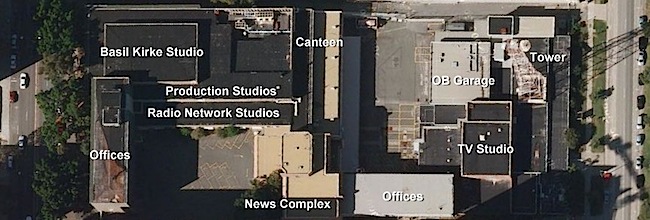
The most recent building on the former ABC site provided a home for radio and television News and Current Affairs. The ground floor housed a splendid sound recording suite for film production. The first floor accommodated the cine cameramen and later editing for electronic news gathering. The second floor housed the radio newsroom. The third floor contained a board room and at one point TV management. Prior to electronic news gathering, all news and current affairs programs used double system film production techniques, where the image was on a separate 16mm film to the 16mm sprocketed magnetic sound recording. It was not uncommon for the news film to be edited until the last moment, requiring a flurry of activity in the minute before the News at 7pm. Film required a count down and videotape content a roll in time, for it to stabilise before broadcast. This complicated the logistics of presentation, but at least the ABC did not have to worry about commercials. Eventually the ABC embraced the use of short promotional recordings between programs, which then avoided the need to show filler material to keep the schedule running to time.
These were the halcyon days of constant local production… as satellites, coaxial cable, fibre optic or microwave links to the eastern states did not exist. Everything had to be made locally or air freighted in. Though ABC Radio did have land lines to the east, the quality was often problematic. National programs arrived by courier with special departments to facilitate the despatch, handling and issue of these prerecorded shows. Later with the microwave link over the Nullarbor, some programs were recorded in Perth as they were broadcast on the east coast. Radio’s audio tape recordings were then replayed here to suit western standard time. Next development was satellite program distribution, and finally digital delay machines. This resulted in a considerable shedding of staff as much of presentation no longer needed to be duplicated.
This has decimated staff numbers at the commercial TV stations too, compared to the years before dramatic technological change.
The ABC in Perth has adapted rather well to change now that there are only 250 staff members. New shared facilities have been built to bring radio and television closer together. Though the new Perth ABC building is on a smaller block at Fielder Street, in the technology and media precinct of East Perth, it is more modern, compact and flexible with an open plan.
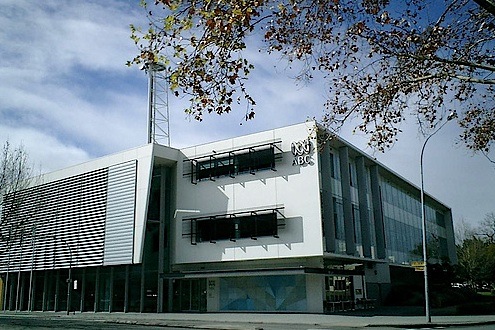
Current State Director, Geoff Duncan, said that the new $50 million building in East Perth was a big investment for the ABC. One of the highlights is the new 600 square metre production studio that ranks alongside those in Sydney and Melbourne. Western Australia can now compete for big productions on an equal facilities basis. Ideal for both large TV shows and film making.
The commercial stations now rely heavily on the ABC for the hire of OB facilities. Since Seven’s Studio One has been mothballed, the big OB van dispensed with and the annual Telethon moved to the Perth Convention Centre, its necessary for Seven to hire the ABC’s modern outside broadcast facilities. This makes good economic sense when few large OB’s are being regularly scheduled by the commercials, other than the football. This trend for hiring facilities is more so in the eastern states where a number of Channel TEN productions are made at the ABC’s Ultimo studios.
Since the ABC became the Australian Broadcasting Corporation in 1983, it has evolved considerably and in the process embraced many new concepts. The ABC has pioneered an online presence to now have one of the most popular web sites in the country. The corporation now gains revenue from the sale of books, music and television programs. Viewers have the on-demand option of watching programs online rather than being constrained by the dictates of programming people. There is also a trend towards narrowcasting rather than have one outlet that tries to cater for all tastes. The ABC covers everything and every demographic from pre-school, children’s, teenage rock, popular, contemporary and classical music to news, comedy, variety, drama, sport and religion. There’s sure to be a program to suit every taste which it delivers by an ever increasing variety of means. One never knows where next the ABC will pop up… once someone invents it… the ABC is sure to be there using it first… from podcasts to digital radio.








Very good write-up and genuinely assists with comprehending the issue much better.
Wonderful to see a photo of Jimmy Fisher after so many years. Well done.
Really enjoyed this article. Very factual plus loads of nostalgia!! Thank you!!
I have located two large CHANNEL 2 ABW EMI Television cameras with computers (big metal tank things and other items) should these be in a museum of some sort. I have photos if you want. They are very cool. Mint green colour. They are probably from the 60s.